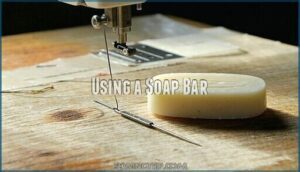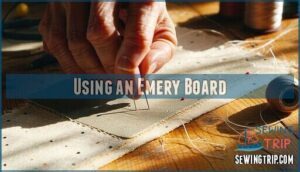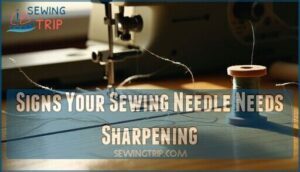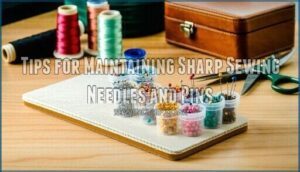This site is supported by our readers. We may earn a commission, at no cost to you, if you purchase through links.

Slide them through a steel wool pincushion, or rub the point with a soap bar for smooth stitching.
Candle flame can help soften grime, while coconut oil adds a slick finish that glides through fabric.
If your thread keeps snapping or stitches look wonky, your needle’s crying for help.
Machine needles, though, prefer a quick swap—sharpening isn’t their cup of tea.
With these tricks, you’ll keep your tools sharp as a tack.
Curious about needle longevity and care? Let’s stitch that together next, and discover the benefits of using candle flame for maintenance.
Table Of Contents
- Key Takeaways
- Can Sewing Needles Be Sharpened?
- Techniques for Sharpening Sewing Needles
- Signs Your Sewing Needle Needs Sharpening
- Do Sewing Needles Get Dull?
- How Long Does a Sewing Needle Last?
- Can You Sharpen Sewing Machine Needles?
- How to Tell if Your Sewing Needle Needs Sharpening
- Tips for Maintaining Sharp Sewing Needles and Pins
- Frequently Asked Questions (FAQs)
- Conclusion
Key Takeaways
- You can bring dull sewing needles and pins back to life with simple tools like emery boards, steel wool pincushions, candle flames, or a swipe through a bar of soap.
- Regularly sharpening and cleaning your needles keeps stitches smooth, protects your fabric from damage, and stops annoying thread breaks.
- Don’t bother sharpening sewing machine needles—just replace them for best results and to avoid damaging your sewing projects or machine.
- Avoid harsh abrasives or tools that can scratch, bend, or corrode your needles; stick to fine materials like emery, steel wool, and coconut oil for safe maintenance.
Can Sewing Needles Be Sharpened?
A sharp needle is a stitcher’s secret weapon—dull points can sabotage even the best plans.
Keep your needle razor-sharp and every stitch glides like silk, turning plans into beautiful creations
The good news is you can absolutely sharpen sewing needles and pins, bringing them back to life and ready for action.
Needle care isn’t just a nice-to-have; it’s what keeps your stitches clean and your fabric safe from snags or tears.
Regular sewing needle sharpening gets you smoother glides through fabric, waving goodbye to thread breakage and uneven seams.
Sharpener tools and everyday Needle Maintenance techniques mean you don’t have to throw out your favorite tools at the first sign of trouble.
Stay proactive with Needle Sharpening Techniques to protect your fabric and enjoy more satisfying, efficient stitching, using your sharp needle as a key tool, and maintaining your tools with good needle care.
Techniques for Sharpening Sewing Needles
You can restore a dull sewing needle to sharpness using a few common materials, so you won’t need to toss it out just yet.
These simple techniques help keep your needles gliding smoothly through fabric for every project.
Using a Candle
If you’re looking for a quick fix, try a candle flame for needle sharpening.
A gentle heat treatment using a candle’s flame softens any grunge on the tip, making it easier to clean and restore sharp sewing needles.
Wax protection builds up as you heat and wipe, helping with needle heating and flame sharpening techniques for smoother stitching.
Understanding proper candle flame sharpening is essential for effective needle maintenance.
Using a Soap Bar
A simple soap bar method can transform your dull needle into a fabric-piercing pro.
Just slide the needle through the soap a few times.
This soap coating delivers needle lubrication, making fabric penetration easier.
It smooths minor imperfections and helps with pin sharpening.
This quick step is a staple in sewing needle care and basic needle sharpening routines.
Proper sewing tools maintenance, including using chalk sharpening techniques, can greatly improve overall sewing performance.
Using an Emery Board
Ever wondered how to revive a dull needle? Grab an emery board and gently rub your needle along the emery surface with quick, downward strokes.
This tried-and-true emery board method quickly restores sharpness, extending your needle’s life. Keep this trusty sharpening tool nearby and add Board Maintenance to your sewing routine for cleaner, smoother stitches.
Using the right Emery Board Needle is essential for effective sharpening.
- Try this for instant, sharp sewing needles!
Using Steel Wool as a Pincushion
After using an emery board, steel wool steps up as your silent workhorse for needle sharpening.
Pop it inside a pin cushion, and as you stab your sharp needles through, the fine filaments handle needle smoothing and pin maintenance with each pass.
The use of a steel wool pincushion is based on effective steel wool products.
Steel Wool Benefits table:
| Pincushion Materials | Wool Sharpening Uses |
|---|---|
| Steel wool core | Needle sharpening, smoothing |
| Cotton fiber blend | Pin storage, gentle polish |
Using Coconut Oil
Coconut oil isn’t just for the kitchen—it’s a handy ally for sewing needle maintenance, too.
Run your needle through a drop of oil, and you’ll notice smoother fabric penetration and fewer breaks.
The benefits of coconut oil shine through as it lubricates and protects, enhancing both needle sharpening and pin maintenance while keeping your stitches clean and sharp.
Signs Your Sewing Needle Needs Sharpening
You’ll notice your sewing needle needs sharpening when thread keeps breaking or stitches look uneven.
If you spot unwanted holes or puckering in the fabric, it’s time to check your needle’s tip.
Your Thread is Breaking
If your thread keeps snapping mid-stitch, don’t blame the yarn quality just yet.
Thread breakage often points to needle damage or a dull tip. A worn needle can snag, cause fabric tears, and mess with sewing tension.
Grab a needle sharpener or try a quick needle sharpening method. Sharp sewing needles make sewing smoother and keep your project frustration-free.
Your Stitches Are Not Even
If you notice your stitches aren’t even, your needle might be losing its edge.
A dull tip can mess with fabric tension and cause inconsistent results.
Before reaching for a new sewing needle set, check for these signs:
- Changes in stitch length or gaps
- Irregular thread quality despite good thread
- Trouble keeping a steady needle angle or sewing speed
A sharp sewing needle improves everything, and it is crucial to maintain a good needle to avoid issues such as inconsistent results.
Unwanted Holes in The Fabric
Every so often, you’ll spot unwanted holes in the fabric—clear signs of fabric damage from a dull needle.
Needle breakage and poor thread tension often cause these sewing errors. Sharpen your sewing needle set to avoid fabric tears.
Regular needle maintenance keeps sharp sewing needles in top shape, ensuring smooth stitching and less chance of accidental damage.
Proper thread tension settings are also essential to prevent such issues.
| Fabric Damage | Needle Breakage | Sewing Errors |
|---|---|---|
| Tiny holes | Bent tip | Uneven seams |
| Tears | Snapped shaft | Skipped stitches |
| Puckering | Blunt point | Loose threads |
| Fraying | Rust spots | Tangled thread |
| Marks | Burrs | Misaligned lines |
The Fabric Puck
A fabric’s puckering can sneak up on you, hinting your sewing needle’s lost its edge. Don’t let fabric damage ruin your project—address puckering causes fast.
Try these sewing hints:
- Check needle care and sharpen with a needle sharpener.
- Adjust fabric tension for smoother stitches.
- Troubleshoot your machine to prevent further fabric puckering.
Sharp sewing needles make all the difference.
Do Sewing Needles Get Dull?
After a handful of sewing sessions, you’ll find your needles aren’t quite as sharp as when you started.
Needle wear is real—microscopic bends and burrs from repeated use lead to a dull needle that drags through fabric. This can cause fabric damage and slow down your sewing efficiency.
Even high-quality needles lose their edge, especially when tackling heavy or synthetic materials.
Sharpness tests, like feeling for snags or roughness, help you spot when it’s time for sewing needle sharpening.
Regular needle sharpening with emery boards, steel wool, or other methods keeps your sharp sewing needles in top shape, boosting needle longevity and smoother stitching every time.
Understanding the correct needle size systems is also vital for superior sewing performance and to prevent damage to your machine.
How Long Does a Sewing Needle Last?
How long does a sewing needle last? That depends on your sewing frequency, needle material, and usage hours.
Most machine needles last 6–10 hours, while hand-sewing needles hold up for 1–2 months. Heavy fabrics or frequent use can shorten needle lifespan fast.
To extend needle life, keep an eye out for these signs:
- Thread breaks or frays
- Uneven stitches
- Unwanted holes in fabric
- Puckering or resistance
Proper storage methods and regular cleaning boost sewing needle durability and delay needle replacement. Regularly checking the needle sizing guide can help determine the best needle for your project.
Can You Sharpen Sewing Machine Needles?
Your sewing machine’s needle might seem tough, but sharpening sewing machine needles is rarely recommended.
Most experts agree: replacing dull machine needles is better for sewing efficiency and needle longevity.
Sharpening tools and needle sharpening techniques designed for hand needles don’t match machine compatibility.
Even the best sewing needle sharpening methods can leave uneven tips, risking fabric and machine damage.
For exceptional needle maintenance and sewing machine maintenance, stick to regular needle changes instead of sharpening.
It’s quick, affordable, and keeps your stitches clean, which is key to overall needle longevity.
How to Tell if Your Sewing Needle Needs Sharpening
After exploring sharpening sewing machine needles, it’s smart to get into Needle Inspection.
Spotting Needle Wear early keeps your sewing on track.
If you notice these issues, it’s time to use needle sharpening methods:
- Stitches aren’t even: Uneven lines signal dullness and poor Thread Tension.
- Unwanted holes: Dull needles lead to Fabric Damage and oversized holes.
- Fabric puckers: Struggling penetration means your needle’s worn.
Regular needle inspection and sewing needle care tips help you master sewing needle sharpening techniques.
Tips for Maintaining Sharp Sewing Needles and Pins
If you’ve just figured out when your needle needs sharpening, it’s time to talk about keeping them in top shape.
Needle Care starts with swapping out dull or bent needles and choosing the right type for your fabric.
Regular Sharpness Testing helps catch wear early.
Pin Maintenance matters too—learn the difference between straight pins, safety pins, and Magic Pins for Sewing Efficiency.
For less poking and easier quilt basting, Pinmoors are a smart choice.
Store needles and pins in dry, organized cases to prevent rust and tip damage.
Clean with a quick pass through an emery board or steel wool.
These needle care tips and sewing needle sharpening tools protect your projects and keep stitching smooth.
Using the right safety pin types can greatly improve your sewing experience.
- Imagine this scenario: Organized pin boxes and a fresh emery board always within reach.
Frequently Asked Questions (FAQs)
Are there any risks or potential drawbacks to sharpening sewing needles?
You might risk bending or breaking needles if you use too much force.
Over-sharpening can weaken the tip or cause rust.
Always check for burrs or rough spots—sometimes it’s smarter to replace than repair.
Are there any historical practices or methods for needle sharpening?
Like a blacksmith forging a blade, you’d use whetstones, emery cloth, or even candle flames to sharpen needles.
Pincushions filled with sand or steel wool were classic tools, keeping your points precise and ready.
How can I tell if my sewing needle needs sharpening?
If your needle snags fabric, makes popping sounds, or feels rough when you run your finger along the tip, it’s time for a tune-up.
Dull needles can cause skipped stitches and thread breaks—don’t let them slow you down.
What materials should be avoided when sharpening needles?
Skip pennies, coarse sandpaper, and toothpaste—they’ll scratch or damage your needle instead of sharpening it.
Don’t use rusty steel wool or rough stones, either.
Stick with fine abrasives and avoid anything that might bend or corrode.
Can sharpening damage specialty or coated sewing pins?
Sharpening can wear down specialty or coated sewing pins, stripping protective finishes or altering unique tips.
If you value those features, it’s better to replace them.
Stick to sharpening basic metal pins for best results.
How often should pins be sharpened during projects?
An ounce of prevention is worth a pound of cure—sharpen your pins every few days or after working with thick fabrics.
If you notice resistance or snagging, don’t wait; a quick touch-up keeps things running smoothly.
Are commercial needle sharpeners better than DIY methods?
You’ll find commercial needle sharpeners offer consistent results and save time, but DIY methods work well if you’re hands-on and creative.
If you love control and flexibility, homemade tricks can match store-bought tools just fine, providing consistent results and allowing for creative approaches.
Does sharpening affect needle performance on delicate fabrics?
When you keep your needles sharp, they glide through delicate fabrics like silk without snagging or tearing.
You’ll notice smoother stitches, less puckering, and fewer thread breaks—think of it as giving your sewing a gentle touch.
Conclusion
Like a knight keeping their sword sharp, keeping your sharpen sewing needles pins in top shape makes every stitch smoother.
You’ve learned how easy it is—whether with an emery board, steel wool, or a candle flame.
Pay attention to snags or wonky stitches, and you’ll catch problems early, which is a simple habit that makes a difference, extending the life of your tools.
Treat your sewing needles well, and they’ll glide through fabric, making every project a breeze from start to finish.
- https://www.quiltingboard.com/main-f1/when-replace-your-sewing-machine-needle-t130852-3.html
- https://kittysewing.com/how-to-tell-if-your-sewing-machine-needle-is-dull/
- https://www.reddit.com/r/sewing/comments/uycbrp/how_often_do_you_replace_your_needle/
- https://youmakeitsimple.com/2019/10/05/sewing-machine-needles-why-choosing-the-right-one-matters/
- https://weallsew.com/all-about-sewing-machine-needles/
















